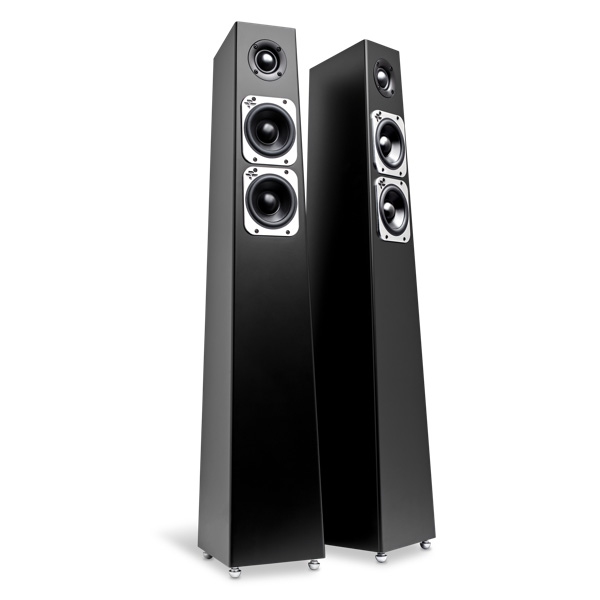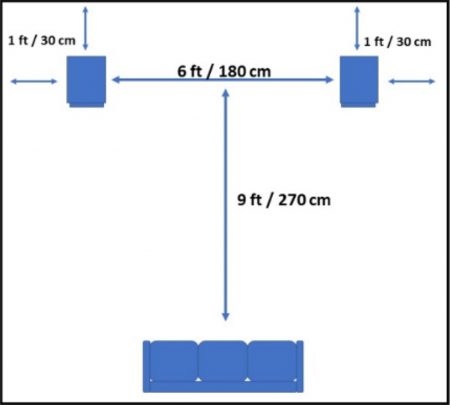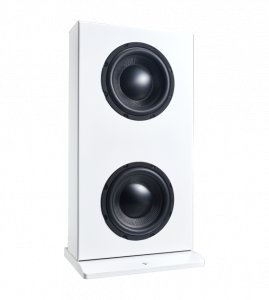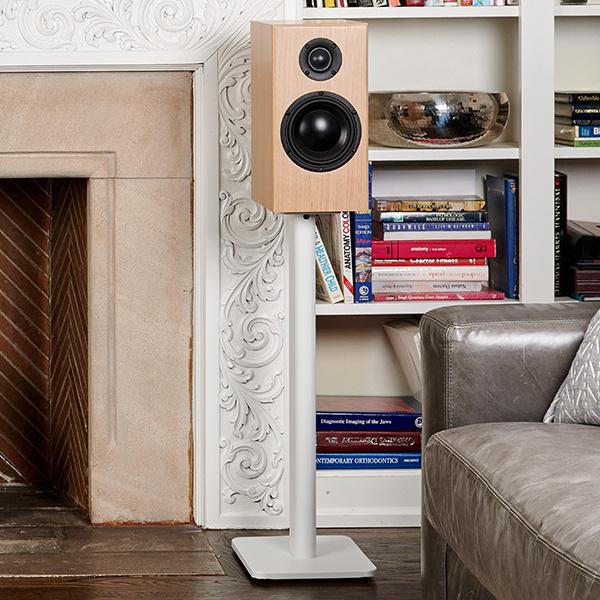
Just like a high performance engine needs some miles on it before being pushed, or an athlete stretching before a game, a speaker needs break in time before it will perform to its full potential.
Totem speakers contain several moving parts that have never actually moved before you have purchased them. Essential pieces of the assembly like the spider and the surround will be stiff at first. Due to the rigidness of your new speakers, they will not be as dynamic until they have had a chance to move and become more flexible.
The easiest answer is simply to play music. However, to break your speakers in well, you’ll want to play something with large dynamic range, something with solid deep bass, as well as something with strong high end. You will want to play the music at a comfortable level but avoid very high volume. If you do it with music that you know well, as you will be able to recognize when the magic starts to happen.
While it varies because each speaker has different components with different characteristics, generally 100 hours is a good average. For Totem, this is sufficient for most of our speakers except those equipped with Torrent technology, which attain their full majesty after 200-300 hours. Consult the setup chart for a more specific guideline for a specific speaker.
Our speakers create a three-dimensional, accurate soundstage without requiring any “toe-in”, or angling towards the listening area. If the distance between them is greater than 8 feet (2.5 m) and the room acoustics are having a substantial effect to the imaging, then you can experiment with angling them. Start by toeing-in one speaker slightly and then the other, if needed. Gradual experimentation is the key.

Totem generally recommends that speakers be positioned 12 in (30.5 cm) from the back wall and side wall to allow a better energy flow and cleaner bass response. Moving them closer to boundaries will result in more bass enhancement but can negatively affect the perceived depth of the soundstage. Moving them farther will result in less bass reinforcement. Placing them anywhere from 4-10 feet (120-300 cm) apart will generally ensure a proper stereo image. A popular guideline is for the listening position distance to be 1.5 times the space between the speakers, so if speakers are 6 feet (180cms) apart you would be 9 feet (270cms) from them. But, all rooms and listening positions are different, so we encourage you to experiment with finding their final ultimate resting spot. We are confident you will thoroughly enjoy them whether they are placed on stands, in a bookshelf, on furniture, wall mounted, and anywhere else you want them.
Consult the Set Up chart for more specific information on each model.
Follow the same guidelines as outlined in the FAQ “What is the suggested Positioning for Totem speakers?” But, there are some differences for bookshelf speakers, based on their size. Bookshelf speakers should be placed on appropriate stands, or shelves, at ear level or above. If they are placed extremely close to the ceiling, you can position them upside down, with the tweeter underneath the woofer. Totem speakers not only image in-between their individual positions but also towards the outside of their axis (both vertical and horizontal). In placing the Bookshelf speakers in room, one may optimize their performance by placing them closer to one another.
Whether surround or stereo, the placement guidelines for the front two channels are the same. Here are some suggestions for the additional channels used home theater set ups.
Surround speakers are generally placed behind and adjacent to the listening area, at a height of approximately 6 feet. In 7.1 systems, they are also located behind the listening position.
Center Channel Speakers are designed for dialog and main action to emanate from come from the video screen. The speakers should therefore be centered to the screen, 20-30 in (50.8 – 76.2 cm) above the floor, preferably equidistant from the main speakers. Our Center Channels are carefully voiced to seamlessly match the appropriate Mains. Please refer to our website www.totemacoustic.com for the appropriate center channel pairing.
Subwoofers can be placed virtually anywhere but closer to corners can enhance their bass output.
The key to maximizing their performance is experimentation. These suggestions are good guidelines to start but you might find that slight tweaks of their position could provide substantially better performance.
Totem speakers feature binding post terminals that accommodate 5 methods of connection: bare wire wrapped around the post, wire through the hole of the post, pin connectors through the posts, banana plugs, and spade lugs. A spade lug size of 8.1mm / 5/16” to 9 mm / 3/8” is required for proper fit. We recommend the WBT 0681 spade for its quality and fit but any spade in the size range can be used.
If your speaker has one set of terminals then standard wire with a positive and negative must be used. If your speaker is equipped with two sets of terminals it can be connected with standard wire, or be bi-wired or bi-amped.
For a standard single wire connection simply leave the jumpers joining the top pair and bottom pair of posts in place. Be certain to connect the positive red (+) terminal of the speaker to the positive red (+) output terminal on the amplifier. Be certain to connect the negative black (-) terminal of the speaker to the negative black (-) output terminal on the amplifier. The speakers will sound out of phase (bass loss and image distortion) if there is an error in your connection.
This eliminates a common impedance seen by the speaker and sends a direct signal to the crossover by keeping the bass and midrange/treble sections separate. This method produces a noticeable improvement in clarity, resolution, and dimensionality.
To bi-wire your speakers, first remove the jumpers and use either two sets of speaker cables or a special bi-wire set. At the speaker end they will separate and at your receiver or amplifier end, they will typically be joined together.
It is important to use identical cables. They should be the same brand, model, and the same exact length. If not, you are changing the electrical properties of the cable and as a result, altering your sound. As with any speaker connections, make sure they are all solid and tight and confirm the positive is not touching the negative side in any way. If you are using bare wire, even a tiny stray strand of wire touching the wrong terminal can eventually damage and blow up your amp. Of course, using wire that is properly pre-terminated is the best option.
We recommend bi-wiring whenever possible.
Bi-amping, however, takes things one step further by using a separate amplifier for the bass connection at your speaker and another one for the treble connection. Just like with bi-wiring, symmetry is super important with passive bi-amping, but it goes one step further. Your speaker cables need to be identical, the connecting audio cables that go to each amp should be identical, and finally, the amplifiers should be identical or from the same brand with the exact same specs in a couple of critical areas. Bi-amping is not required with Totem speakers but you can always experiment with the option if desired.
Some speakers allow Mass Loading, or adding a dry particulate like clean dry sand, silica sand, or non-odor kitty litter to an enclosed cavity within your speaker. Bass loading can provide two benefits. It adds more mass to the speaker and helps improve stability. It can also fine tune the bass response, tightening up the output and relieving room acoustic that might be overemphasizing certain frequencies. All Totem Floorstanding models work very well without any type of mass loading, but you can experiment with it should you want to hear the difference.
There is no right or wrong answer for the question of what amp is recommended for a given speaker. You need to consider your personal listening preferences, budget, and application. Totem dealers are carefully chosen for their expertise and product selection so discuss talk your options with your local dealer and audition your speaker with their suggested amplifier combination.
When it comes to KIN products like the KIN Monitor or Flex, we have found that our own KIN Amp is hard to beat.
Much like the choice of amplifiers, there are many options and your authorized dealer can help with the selection, based on their own experience. However, Totem does manufacture our own speaker wire as well called Tress. It is a twisted pair of 14-gauge, multi stand, linearized oxygen-free silver-plated conductors coated in black and white Teflon. Dielectric shielding makes it impervious to damage and oxidization. Tress can be run long distances -in-wall and around room and are thin enough to be easily accommodated. It provides great extension in both high and low frequencies, excellent spatial ability, has no capacitance buildup, and is FT4 rated. It is one of the best performers out there, yet remarkably economical.
Tress is also available in a bi-wire format, featuring a single stranded pair to a double stranded pair. These cables also include 12 WBT terminals.
| Model | Placement from Rear Wall | Placement Distance Apart | Break-in Time |
|---|---|---|---|
| Rainmaker | 1′ – 3′ / 30.48 – 91.44 cm | 2′ – 8′ / 60.96 – 243.84 cm | 71 – 100 hours |
| Skylight6 | 6″ – 3′ / 15.24 – 91.44 cm | 2′ – 8′ / 60.96 – 243.84 cm | 70 – 100 hours |
| Sky | 6″ – 3′ / 15.24 – 91.44 cm | 2′ – 8′ / 60.96 – 243.84 cm | 70 – 100 hours |
| Signature One | 1′ – 3′ / 30.48 – 91.44 cm | 4′ – 12′ / 121.92 – 365.76 cm | 100-150 hours |
| Element Ember | As little as 6″ / 15.24cms, but varies based on electronics and room acoustics | As little as 2′ / 60.1 cms, but varies based on electronics and room acoustics | 200-300 hours |
| Element Fire | As little as 6″ / 15.24cms, but varies based on electronics and room acoustics | As little as 2′ / 60.1 cms, but varies based on electronics and room acoustics | 200-300 hours |
| Arro | 6″ – 3′ / 15.24 – 91.4 cm | 2′ – 12′ / 60.96 – 365.76 cm | 100-150 hours |
| Sky Tower | 9’’ – 3′ / 22.86 – 91.44 cm | 2′ – 8′ / 60.96 – 243.84 cm | 70 – 100 hours |
| Hawk | 1′ – 6′ / 30.48 – 182.88 cm | 3′ – 8′ / 91.44 – 243.84 cm | 60 – 80 hours |
| Forest | 1′ – 6′ / 30.48 – 182.88 cm | 4′ – 12′ / 121.92 – 365.76 cm | 100-150 hours |
| Forest Signature | 1′ – 6′ / 30.48 – 182.88 cm | 4′ – 12′ / 121.92 – 365.76 cm | 100-150 hours |
| Wind | 3′ – 7′ / 91.44 – 213.36 cm | 6′ – 14′ / 182.88 – 426.72 cm | 200 – 250 hours |
| Wind Design | 3′ – 7′ / 91.44 – 213.36 cm | 6′ – 14′ / 182.88 – 426.72 cm | 200 – 250 hours |
| Tribe Tower | 4″ / 10.16 cm | 2′-15’ / 60.1- 457.2 cm | 100-200 hours |
| Element Earth | As little as 6″ / 15.24cms, but varies based on electronics and room acoustics | As little as 2′ / 60.1 cms, but varies based on electronics and room acoustics | 200 – 300 hours |
| Element Metal | As little as 6″ / 15.24cms, but varies based on electronics and room acoustics | As little as 2′ / 60.1 cms, but varies based on electronics and room acoustics | 200 – 300 hours |

This control determines the frequencies the subwoofer will play. This frequency is manually controlled and is continuously variable between 40-200Hz. Generally, Totem speakers are set between 40 and 70 Hz for floor-standing speakers and 70Hz and above for Bookshelf speakers. You can experiment with which position works best with your main speakers by turning this control until the sound of the low frequency coming from the subwoofer is nicely blended with the sound of your main speakers.
This control adjusts the phase, or time alignment, of the bass output to that of your main speakers. When in phase, the system will produce a much fuller bass response. The simplest way to adjust the phase of your system is to have a second individual to adjust the phase dial as you sit in the listening position.
The LFE/Sub Out Connection the most popular method for connecting a subwoofer and is used with most stereo receivers, surround receivers, and some integrated amplifiers.
This method requires setup in the bass management section of the receiver to determine which frequencies are sent to the subwoofer and speakers. Speakers can be set to large or small, the crossover point can be set, and even the volume output are all regulated within the bass management section. Set Volume to 80%, Crossover to its highest point, and Phase at 0 on the subwoofer when using it in conjunction with any type of bass management or room correction software.
Use a subwoofer cable to connect the amp/receiver’s SUB OUT (Can also be called LFE Out, or PRE-OUT on pre-amps and surround processors) to the LFE (low Frequency Effect) input on the sub.

LFE Connection with a “Y” RCA
You can also make this connection with a “Y” RCA to fill both inputs on the sub. This connection is virtually identical to the connection method above except it uses a “Y” wire to fill the left and right inputs on the sub which generally results in a slightly stronger output.
The most popular option is the Pre-Out connection method. This method is typically used with integrated amplifiers and some stereo receivers. The speakers will continue to reproduce bass frequencies and you must use the subwoofer’s controls to find the perfect blend between it and the speakers. The integrated amplifier is usually equipped with stereo (Right and Left) Pre Outputs so it can be connected to the subwoofer’s right and left inputs with a stereo RCA wire. This is a common connection with integrated amplifiers.

In this situation, you would need a subwoofer equipped with high level, or speaker wire inputs. When using this connection method, both left and right channels must be connected since different bass information might be present in each channel going to your main speakers. Crossover point and subsequent frequencies sent to the speakers are set on the subwoofer.
Connect both pair of speaker wires from the amplifier’s speaker outputs to the Sub high-level inputs. (It is important to respect polarity (+/-) and the right/ left channel of your speaker wire). These wires are colored gold in the image below. Using a second set of speaker wire, connect from the very same Sub high level terminals to the appropriate loudspeaker, once again respecting polarity and channel. These wires are colored blue in the image below. You can facilitate the process by twisting together each set in each terminal.


Bring the product and copy of the bill to the authorized dealer where it was purchased. If they must be shipped, they are required to be shipped in their original packaging. This ensures no damage during transportation.
Totem’s speakers are covered by a five (5) year limited warranty, starting from the date of purchase.
Totem’s subwoofers are covered by a five (5) year limited warranty, on the driver, two (2) year limited warranty on the amplifier, starting from the date of purchase.
Totem’s subwoofers are covered by a five (5) year limited warranty, on the driver, two (2) year limited warranty on the amplifier, starting from the date of purchase.
Speakers sold as ‘demo’ or ‘floor models’ from an authorized dealer have a limited warranty of 1-year parts and service from the date of purchase. Cosmetic issues or missing accessories are not covered by this limited warranty.
The Totem limited warranty applies to products in normal home use only. The warranty is void if serial numbers have been altered or removed. The warranty is void if products show signs of abuse. The warranty is void if the speakers have been tampered with.
Yes, but you must have the original proof of purchase and the speakers cannot have any of the characteristics that can void the warranty.
Parts can be ordered from your dealer or distributor, who are generally also your authorized service center. Many Totem parts, such as drivers, are soldered directly to wires so they are not easy to replace and should be serviced by an authorized service center. Consult our Service + Parts page to find your local dealer or distributor.
